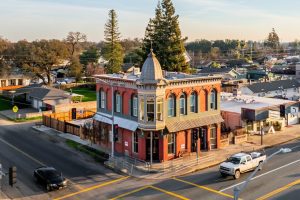Lockeford Rural Community Project
Situated in central California, 80 miles east of San Francisco and 95 miles south of Sacramento, and nestled in the valley between San Joaquin and Calaveras Counties is a small rural community called Lockeford. The small town was established in 1851 by Dean Jewett Locke and his brother, who, after settling there, built a ranch, which then expanded into a small town. It was Dean Locke’s wife who later coined the term Lockeford as the name of the town, which was a reference to a Ford Locke had built. Today, the community has a population of less than 5,000 people, and due to the small size of the population, it is closely knit. The demographics of the community area follows: white people are the majority, making up 75.55%; two or more races make up about 10.08%; Native Americans are 3.47%; Asians 1.04%; African Americans 0.12%; and the rest 0.07% are Native Hawaiian (World Population Review, 2024). Some of the popular activities in the area are hiking and fishing, while the main economic activities are agriculture and manufacturing. Since I reside in Stockton, Lockeford is a separate and smaller community from mine, and therefore, I am an outsider to them.
Ethical Dilemmas
Suppose, as a social worker, I were to work with this community, some ethical challenges that I would face would include maintaining confidentiality. One of the key characteristics of small rural communities is that they are closely knit, meaning that frequent exchanges between the members and even private matters, such as marital problems, tend to be hard to keep secret. As a social worker, especially an outsider, I have to integrate myself into this community and earn their trust so that they can consider me one of them because this is the only way I can work effectively. As such, I have to be part of these personal interactions and adapt to the norms of personal relationships, which means that there is an overlap between my professional and personal life. This can bring up ethical dilemmas, as I have to navigate what to share as a member of the community and what not to share as a social worker. Notably, as addressed in Section 1.07 of the code of ethics, confidentiality is a core tenet of social work (Daley & Hickman, 2011).
Another ethical dilemma I may face is personal disclosure. In order to fit in with the community, I would have to practice personal disclosure, but this can be a double-edged sword. Revealing too much information about myself could make the community members question my ability to effectively do my job. Conversely, not disclosing enough information may make me appear aloof or superior to them, which is also negative. Further, in a community with basically no anonymity, if I were to have personal issues and needed help, this would potentially become public information, affecting my professional image and effectiveness. My unwillingness to seek help would conflict with the ethical provision in the Code of Ethics section 4.05 (b) (Daley & Hickman, 2011), which dictates as a social worker, I should look for help as soon as private troubles interfere with my professional performance and judgment. Notably, if a social worker is not sufficiently open, it can raise concerns about competence in Code section 4.01 or misrepresentation in Code section 4.06. On the other hand, excessive openness can blur the lines between private and professional conduct, as stated in Code section 4.03, and affect the social worker’s competence as per Code section 4.01 (Daley & Hickman, 2011).
Lastly, yet importantly, I would also face ethical challenges in regard to my colleagues. In a closely knit community, those I work with will have close relationships with people in the community, including my boss. For instance, the connection that my supervisor has with the community may make it difficult for me to discuss some issues openly. The overlapping relationships social workers have with the community, who are also their clients, create a significant source of ethical conflicts.
Community Culture
As a burgeoning wine town, Lockeford has a rich agricultural heritage with a strong sense of community. The town has various renowned vineyards in Lodi, and it also has many small farms. In addition, the community can be described as a cowboy enclave, especially with the bustling Rancho Murieta event center and the storied Clements rodeo grounds, which are indications of cowboy culture. Further, the community also arranges annual events, such as the Lockeford Street Faire, a reflection of its close-knit and traditional values.
Unique Characteristics
One of the unique characteristics of this small town is the various historical buildings that date back to the 1800s when the town was being established. An example of this is the Lockeford Emporium, built in 1883. It is the sentinel of the American West and is considered a historical treasure within the community. Another distinguishing feature of the town is that it combines elements of a wine town and a cowboy town, as there are cowboys and vineyards in the vicinity.
Figure 1
Lockeford Emporium
Note. From “Property Listings Archive – Page 9 of 451 – California Outdoor Properties,” by California Outdoor Properties (https://www.californiaoutdoorproperties.com/listing/page/9). Copyright 2024 by California Outdoor Properties.
Prominent Challenges
One of the prominent challenges of Lockeford town is that it is mainly dependent on agriculture, which is vulnerable to fluctuations as market prices and environmental factors occur. Secondly, Lockeford significantly depends on local tourism, which makes the community vulnerable to external shocks, such as economic downturns. Additionally, since its establishment, most of its infrastructure today is centuries old, which means that the old age of the buildings poses a threat to the residents. The community’s response to the agricultural dependence challenge is through economic initiatives; for instance, local farms and businesses have formed cooperatives to manage resources and find ways to market their produce. Secondly, residents of the area who own the old building are taking the initiative to renovate the old building and make it safer and modern.
Needs and Struggles
One need that Lockeford struggles with is slower economic growth due to isolation. Rural communities in isolation means that they have limited access to the resources that urban areas have. In addition, the fewer people live in an area, the fewer economic activities will take place. As such, fewer employment opportunities will be available, which translates to little to no development of infrastructure. Such communities then experience lower revenues and economic stagnation.
Creative Solution
The creative solution I would use to address the economic challenges faced by Lockeford is the development of a Rural Innovation Hub, which would serve as a multifaceted center aimed at fostering economic growth, enhancing skills, and promoting connectivity. One of the components of the rural innovation hub would be co-working spaces and business incubators for local entrepreneurs and startups. These would not only support small businesses and attract new ventures; they would also provide funding opportunities and other resources to help startups grow. The second component is digital infrastructure development, which would comprise investing in high-speed internet and digital infrastructure. This would allow local businesses to start operating online and be able to access global markets. Further, it will be attractive to digital nomads and remote workers who would contribute to the growth of the local economy. The third component would be educational and training programs for community members that would provide vocational training and workshops in fields that have high demand. This would result in a local workforce with high skill sets, making them ideal for industries that require skilled labor.
A theory I would apply to my idea of a Rural Innovation Hub idea is the Endogenous Growth Theory. This is an economic theory that posits that economic growth is primarily generated from inside the system due to internal factors as opposed to external ones (Apostol, Enriquez & Sumaway, 2022). Moreover, the theory emphasizes that enhancing human capital results in the development of the economy through innovation, effectiveness, and efficiency in the production processes. Notably, the theory also emphasizes the significance of local resources and skills in nurturing sustainable development (Șerban, 2020). By highlighting the importance of technological advancement, local innovation, and skill development in economic growth, this theory would support my idea of a Rural Innovation Hub. By investing in training, digital set-up, and local entrepreneurship, Lockeford can rouse internal economic activities that result in continuous economic progress.
References
Apostol, M., Enriquez, H. A., & Sumaway, O. (2022). Innovation factors and their effect on the GDP per capita of selected ASEAN countries: An application of Paul Romer’s endogenous growth theory. International journal of social and management studies, 3(2), 119-139.
California Outdoor Properties. (n.d.). Property listings archive – Page 9 of 451 – California Outdoor Properties. https://www.californiaoutdoorproperties.com/listing/page/9
Daley, M. R., & Hickman, S. (2011). Dual relations and beyond: Understanding and addressing ethical challenges for rural social work. Journal of Social Work Values and Ethics, 8(1), 99-108.
Șerban, O. (2020, December). From endogenous growth theory to knowledge economy pyramid-comparative analysis of knowledge as an endogenous factor of development. In International Conference Innovative Business Management & Global Entrepreneurship (IBMAGE 2020) (pp. 108-128). Editura Lumen, Asociatia Lumen.
World Population Review. (2024). Lockeford, California population 2024. https://worldpopulationreview.com/us-cities/lockeford-ca-population
ORDER A PLAGIARISM-FREE PAPER HERE
We’ll write everything from scratch
Question

Lockeford Rural Community Project
This is to be a 5–7-page paper. It is to be done in a 12-point type font, APA 7th ed. Answer the following questions in your write-up.
*I want you to look for a rural community close to you.
*Are you a part of this community or an “outsider”
*Identify ethical challenges for working with this community.
*Find out what the culture is in the community.
*Identify what is unique about this community.
*Identify the prominent challenges in the community and identify how the community deals with these challenges currently.
*Do you see any needs in this community that they struggle to receive due to being rural?
*Come up with one creative idea to address this problem and discuss how you would implement it.
*Identify at least one theory you would use in your idea for this community. Make sure you are using peer-reviewed articles to back up your idea.
*Include any pictures or website links that are appropriate and do not violate anyone’s privacy.


